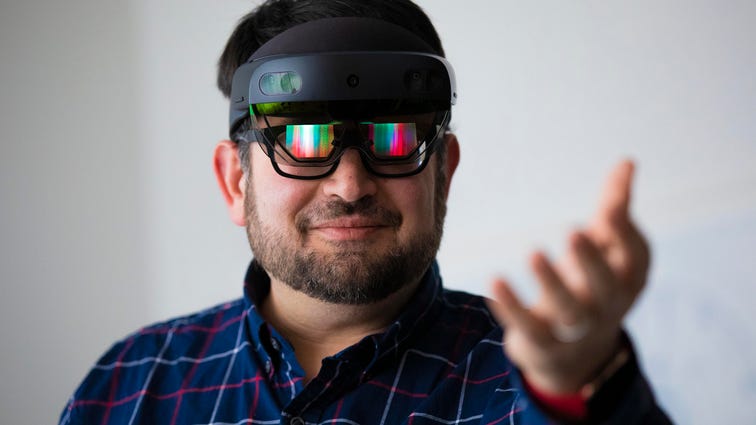
By Ian Sherr
Ask me to fix a broken car or motorbike, and you’d be out of luck.
But that’s exactly what Microsoft wanted me to do. And the tool it gave me was its new mixed reality HoloLens 2 headset.
After I slipped it on, a set of digital instructions popped up over an actual broken ATV, set up in a mock repair shop at Microsoft’s headquarters. There were buckets of bolts to my right side and tools to my left. Then a set of neon-blue cartoonish arrows appeared, pointing at which gears I needed to move and where to move them to start the repair.
Next, I was told to get parts from bins around the room. The blue arrow directed me to the bin with the bolt I needed, then the washer to go with it, and then to a table with the right wrench.
Which size bolt? What type of wrench? I didn’t need to worry about that, because the HoloLens 2 guided me every step of the way. After about eight minutes, I went from cluelessly looking at a broken ATV to marveling at my first repair job. As Keanu Reeves says in the sci-fi epic The Matrix after getting fighting skills downloaded directly to his brain, “I know kung fu.”
This is the promise of Microsoft’s HoloLens: a computer that can help you do pretty much anything you’d use your hands for. It does this by sensing where it is in a building and then laying computer images on top of the real world you’re actually seeing. And unlike Microsoft’s original HoloLens, announced four years ago, this new headset is more comfortable and easier to use.
That makes working with HoloLens that much more immersive when you’re looking at the holograms it’s creating. And those can be anything from a massive movie screen to a model of a new building. Or a set of instructions showing you how to bake a batch of cookies or repair an aircraft engine. And with a pair of cameras, the headset can also be a phone-a-friend, allowing anyone to see through the eyes of whoever’s wearing the headset. Think about that. Your friends can also use an app to circle things they see, which show up as holographic notations when you’re wearing the headset.
“The goal is these things will transform humans,” HoloLens leader Alex Kipman said in an interview at Microsoft’s Redmond, Washington, headquarters. “They’ll empower people and organizations to do things they plainly were not able to do before.”
Microsoft isn’t crazy for thinking big about the potential of these headsets. The tech industry’s brightest minds are already investing billions of dollars to develop mixed reality (or, as some call it, augmented reality). They’re all betting it’ll change the way we use computers in the next few years. The market for AR gear is expected to explode, from under $6 billion last year to almost $200 billion by 2025, according to data compiled by Statista.
“We don’t have to just imagine it, this future is here,” Microsoft CEO Satya Nadella said at an event announcing the device Sunday at Mobile World Congress (MWC) in Barcelona. “Together, these advances are shaping the next phase of innovation.”
A high-profile startup called Magic Leap started shipping a $2,295 headsetlast August after working on it for seven years and raising $2.3 billion in investment from backers including AT&T, Google and Warner Bros. Facebook, which sells a $399 fully immersive virtual reality headset called the Oculus Rift, is working on a HoloLens competitor as well. Even Apple is secretly building one, which sources told CNET may arrive in 2020.
Microsoft is opening preorders for the HoloLens 2 on Feb. 24 for $3,500. The company plans to ship the device later this year.
HoloLens (the name is inspired by holograms) sounded straight out of sci-fi when it was first demoed. “We’re not talking about putting you into virtual worlds,” Kipman said when he introduced the device in 2015. “We’re dreaming beyond virtual worlds, beyond screens, beyond pixels.”
But HoloLens had its problems. The original headset was hard to put on. It felt heavy at nearly 1.3 pounds, which is a little heavier than an iPad Air. The HoloLens squeezed some people’s heads, too. It didn’t always fit over your glasses. At $5,000, it was expensive. And the software used to run it often needed extra setup and adjustment.
The worst part was that the holograms appeared in an area in front of you that was only about the size of a deck of cards. (In AR parlance, that area’s called the field of view.) Practically, that meant you usually saw only a small portion of a hologram.
“The previous headset’s field of view was its biggest drawback,” said Scott Stein, CNET’s senior editor for reviews, who’s tried on more headsets than I knew existed. “Virtual objects have to be lined up just right, and the drop-off breaks the illusion and adds some fatigue trying to find things again.”
So Microsoft set out to fix those problems. Kipman invited Stein, CNET Español Managing Editor Gabriel Sama and me to the company’s headquarters to see what it’s accomplished with HoloLens 2. And to share the promise of HoloLens 3 and beyond.
Bottom line, according to Kipman: “We have a lot of work left ahead of us.”
